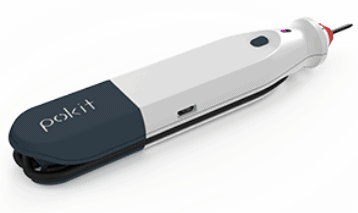A multimeter is one of the most versatile tools you can have in your toolkit. It is a handy device that measures various electrical values such as voltage, current, and resistance.
It’s a must-have for technicians in the electrical and electronics industries, but it’s also great for DIY projects and household electrical work. In this post, we’ll outline everything you need to know about a multimeter — how to use it, its features and advantages, the general upkeep and maintenance, plus the best safety practices for using one.
How to use a multimeter
Let’s start off with the basics on how to use your multimeter. Select the appropriate measurement setting using the slider switch on the Pokit Pro, and selecting Multimeter on the app (Pokit Meter uses app only). Then, connect the probes to the circuit or component you’re testing. For DC measurements, the black probe should be connected to the negative terminal and the red probe should be connected to the positive terminal. Finally, read the measurement displayed in the app and save the measurement to history for later.
To measure voltage, navigate to the multimeter module in the app, then select voltage mode (AC or DC). Connect the probes to the circuit or component, with the red probe connected to the positive terminal and the black probe connected to the negative terminal.
To measure current, navigate to the multimeter module in the app, then select current mode (AC or DC). Connect the probes in series with the circuit. The red probe measures the current flowing into the device and the black probe measures the current flowing out of the device.
And for resistance, navigate to the multimeter module in the app, then select resistance mode. Connect the probes to the circuit or component with the red probe connected to one end and the black probe connected to the other end. The multimeter sends a small current through the component and measures the voltage drop across it to determine the resistance.
For a full list of Pokit multimeter measurement modes visit: Pokit Specifications Sheet
What do I use a multimeter for?
When you think of a multimeter, you may immediately assume it’s a tool predominantly used in a professional setting, but it’s an incredibly useful tool when it comes to home improvement projects.
You can use it to troubleshoot electrical problems in your home or car, test the continuity of wires and circuits, measure voltage and current in various electrical systems, check for electrical hazards, and even optimize your bitcoin mining setup. It’s also great for checking the health of batteries to check if they are still viable or not, transistors, and other electronic components, and measuring the resistance and continuity of fuses and relays.
A multimeter is also a vital tool for troubleshooting electrical problems. By regularly measuring voltage, current, and resistance, you can manage and identify issues in a circuit or component and make repairs as needed.
What are the main advantages of a multimeter?
The main advantage to using a multimeter is that it eliminates the need for multiple specialized tools, making it a more cost-effective option. It’s also compact and easy to use, making it a great option for both professionals and hobbyists.
What is the upkeep of a multimeter?
Calibrating a multimeter is an important step to ensure accurate measurements. Calibration is the process of adjusting the multimeter’s settings to match a known reference measurement. This ensures your measurements are as accurate as possible.
Pokit devices are calibrated in the factory prior to delivery and are guaranteed to be within specification. If required, Pokit Pro can be calibrated by professionals using the calibration table.
For professionals, it’s important to perform regular calibrations, as it will ensure that your multimeter is always providing accurate readings, and it will help you to meet industry and safety standards. Not only that but it will also increase the longevity of your multimeter by keeping it in optimal working condition.
Please ensure that you calibrate your Pokit Pro against a known reference from a source that has been calibrated.
Find out more about Pokit Pro’s calibration table here: Pokit Calibration Guide
How do I use a multimeter safely?
Safety is always the highest priority when working with electrical circuits. So here are some important precautions to keep in mind when using a multimeter:
- Wherever possible, unplug the device or turn off the power before using the multimeter
- Don’t touch the probes while the device is still connected to a live circuit.
- Make sure the multimeter is set to the correct measurement mode.
- Use caution when working with high-voltage circuits and wear protective gear like rubber-soled shoes, appropriately rated gloves and safety glasses.
- Work in a dry and well-lit area and avoid using the multimeter near flammable materials.
- Follow the user manual instructions for use and maintenance.
- Keep the multimeter in good condition and handle it with care.
So, there you have it — everything you need to know about a multimeter. It’s a powerful and versatile tool that can be used for a wide range of electrical tasks. Whether you’re a professional or a hobbyist, a multimeter is a must-have in your toolbox.
Pokit Innovations creates the world’s smallest wireless all-in-one multimeter, DSO and loggers. Pokit Innovations is disrupting the electronics test and measurement industry. Our test gear is extremely portable, versatile, accurate and affordable.







